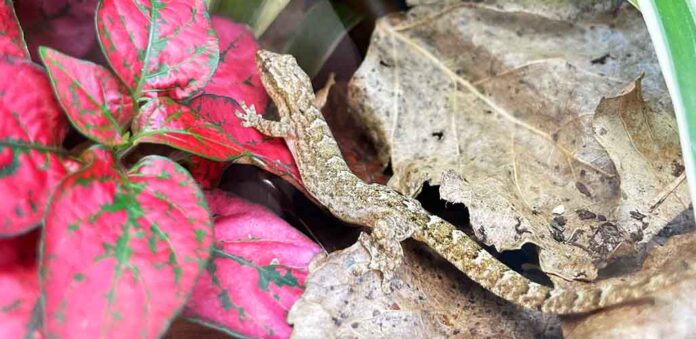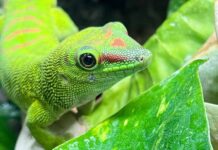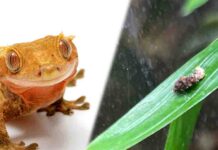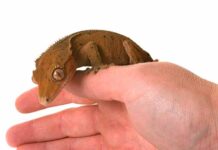The Mourning Gecko makes a great pet for experienced and novice reptile keepers, yet they are surprisingly uncommon and misrepresented. Until I brought home my girls, I had no idea that they were so well camouflaged, super fast, and good at hiding. They might be a quarter of the size of some of my other pet geckos, but that doesn’t reduce the fun!
Not only are they tiny ninjas, some of these little cuties crawl into holes and under the substrate as often as they live up to their arboreal reputation! From tropical coastal regions originally, they are seriously cool pets with some unusual traits. One of which, parthenogenesis, can make them rather controversial to keep!
Contents
- Breeding Mourning Geckos
- What do Mourning Geckos look like?
- Mourning Gecko size
- Setting up your Mourning Gecko terrarium
- Heat, misting and lighting
- Mourning Gecko food and feeding
- Lifespan and health
- Handling a Mourning Gecko
- Do you get male Mourning Geckos?
- Are Mourning Geckos good pets?
Mourning Geckos are also known as Smooth scaled geckos or Lepidodactylus lugubris to use their scientific latin name. They are small, growing up to 4 inches at most, quick and shy. They have pointed noses, with long and patterned bodies.
This isn’t an easy to handle pet, but it sure is fun to watch these climbing lizards roam and hide around their terrarium. Especially since you can keep them in groups, and even with some other species like Dart Frogs! Naturally blended in dark colors, they eat a gecko food mix along with small insects like crickets and roaches, which give them entertainment through hunting as well as exercise. Today we’ll share top tips for setting up your live planted bioactive Mourning Gecko terrarium, and keeping your tiny lizards happy and healthy.
Mourning Gecko Reproduction
Mourning Geckos are famously almost totally female only – I’ll explain how that works in a moment.
You’ll sometimes find their name incorrectly spelled as Morning Gecko. Their correct name, however, has nothing to do with the time of day, and is thought to be related to the mournful chirps the females make, as they call to all the lost male mourning geckos!
It’s a romantic explanation, but the reproductive habits of these creatures is a very unusual and interesting one.
Parthenogenesis
Mourning Geckos make eggs through a process called parthenogenesis. That means the females, which is all of them, produce and fertilize eggs all by themselves! Breeding these Geckos is therefore incredibly easy, and the only real risk is over populating your tank.
Parthenogenesis is unusual in higher animals. It’s a bit like cloning, in that all the offspring are genetic copies of their parent. Unlike reproduction involving two parents, parthenogenesis does not lead to genetic diversity. This is an evolutionary disadvantage as it does not enable a species to adapt to a changing environment.
What it does mean, is that if you own Mourning Geckos, the likelihood is you’ll also be breeding them.
Mourning Gecko Eggs
These female only Geckos lay eggs regularly, attaching them to the leaves in their terrarium. Those eggs are held on by a natural sticky glue until they are ready to hatch.
If you leave the eggs in the terrarium to hatch they are likely to survive, but you might want to temporarily remove the babies as it’s possible the mothers might forget what they are and eat them!
I currently have a small handful of babies in with their mothers, and one in an old mantis tub on my desk. She managed to escape from the main tank and I caught her about to become one of the other gecko’s lunch!
Mourning Gecko Types
There are a few color variations of Mourning Geckos that get referred to as types. Some are more distinctive than others, but they are all patterned with natural tones of tan, brown and green. These colors are flecked and laid around their bodies, limbs and heads in light to dark shades with dark spots.
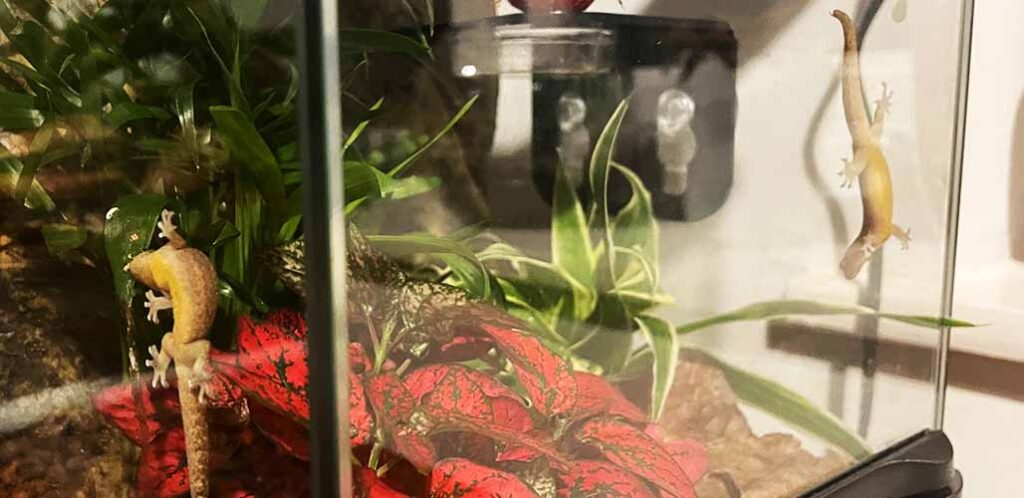
Mourning Gecko Full Size
Mourning Gecko babies are tiny and delicate. And as adults they aren’t an awful lot bigger.
If you’re used to handling Crested, Leopard or Gargoyle Geckos these little cuties might surprise you. They are more slightly built, and only grow up to 4 inches in length.
Mourning Gecko Enclosure
An ideal Mourning Gecko enclosure is a terrarium measuring 18 x 18 x 24 inches. You can put them in a smaller tank but it’s worth remembering that they will multiply. Unless you are going to find homes for your little baby lizards ever time they reproduce, you’ll want this slightly larger tank size to accommodate their new arrivals.
Although social, these little lizards still need lots of different places to hide and explore. They like each other and are not usually aggressive, unless densely over populated. Another good reason to set up a large tank.
Bioactive Mourning Gecko Terrariums
We prefer to keep our lizards in a more natural bioactive enclosure. This isn’t essential, but will mean that you can allow the eggs to hatch in their tank rather than risking removing them. I also totally love setting up bioactives environments, it’s incredibly satisfying to watch your own ecosystem flourish.
Bioactive terrariums need a drainage layer of clay balls, a dividing layer of wool or a similar substance, and then some natural dirt layer on top. You can plant directly into this top layer and stand any decorative bark, cork or sticks on it.
Do Mourning Geckos Need UVB?
I give my Mourning Geckos an arboreal level UVB light during daytime hours for a few reasons. Firstly because they are awake during the day sometimes and so would naturally be in the sunlight at points. Secondly, because there are live plants in the terrarium that grow best under some level of UV light.
Room temperature is fine for Mourning Geckos, although we recommend a heat lamp for colder houses in winter. They will need spraying down with a water bottle twice a day, with the tank being left in the intervening period to dry out slightly.
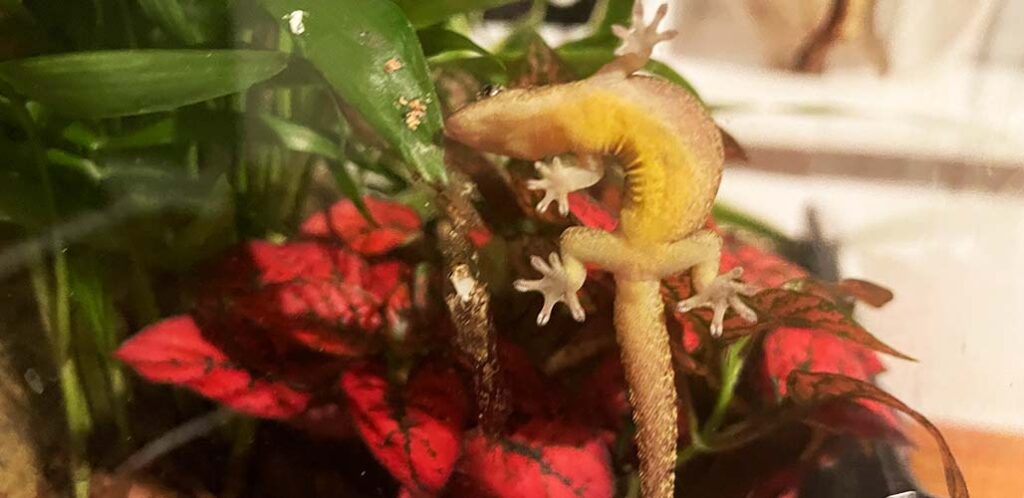
Mourning Gecko Diet
Their natural diet includes a wide range of small animals and plant matter. But you can feed Mourning Geckos on a tiny dollop of Crested Gecko mix by Repashy or similar brands. I take a teaspoon from my crestie’s bowl and pop it into a separate dish for the tiny gecko tank.
Your pet will also benefit from access to live food. This can be fruit flies, small crickets or mealworms. I offer them access to hunting life food about twice a week, but they also predate the baby isopods that act as a cleanup crew.
How Long Do Mourning Geckos Live In Captivity?
Reptile lifespans are often assumed to be shorter than they should be, because their care requires a delicate balance. Although many pet Mourning Geckos have sadly short lifespans, they should if kept correctly live around 15 years.
Handling Your Gecko
It is possible to handle Mourning Geckos, but they are normally more of an ornamental species. They are fast, shy and asleep during the day. It would be very easy to release one when lifting them out of the tank, and very tricky to catch them again when you do.
When I open my girls’ tank I always check that they aren’t near the door, so they don’t escape or get trapped in the gap that swings open. I also keep a tiny pet fish net handy, just in case they manage to make a break for it. I’ve not had to use it yet, but I’m always a little relieved to know it’s there when I open up!
Male Mourning Geckos
While to my knowledge no male Mourning Geckos have ever been bred in captivity, it is said that a few have been found in the wild. However, boys are almost always sterile. And if one did come about that was fertile, they’d have a tough time finding a female to mate with that couldn’t happily do the job solo. So although technically a tiny percentage of Mourning Geckos is possibly male, they are a bit of a redundant line due to their female friends’ amazing parthenogenesis. This is a fabulously fascinating thing for us as reptile enthusiasts and scientists, but sadly not a great indicator of the long term viability of the breed.
Are Mourning Geckos Good Pets?
These tiny Geckos are great pets for reptile enthusiasts that don’t mind a bit of a hands-off experience. They are cheap because they are so easy to breed, and relatively simple to find in most regions of the US. Although they took me quite a while to find in the UK!
Due to their flighty nature, I’d say they are better suited to a keeper with some pet experience, even if not reptile experience. However, I love my Mourning Geckos and I can’t imagine there are many enthusiasts that wouldn’t adore watching these twitchy little creatures explore their terrarium.
More About Pet Reptiles
Not sure Mourning Geckos are the right match for you? Check out these other lovely lizards, snakes and tortoises!
- Albino leopard geckos
- Viper geckos
- Albino bearded dragons
- Albino corn snakes

